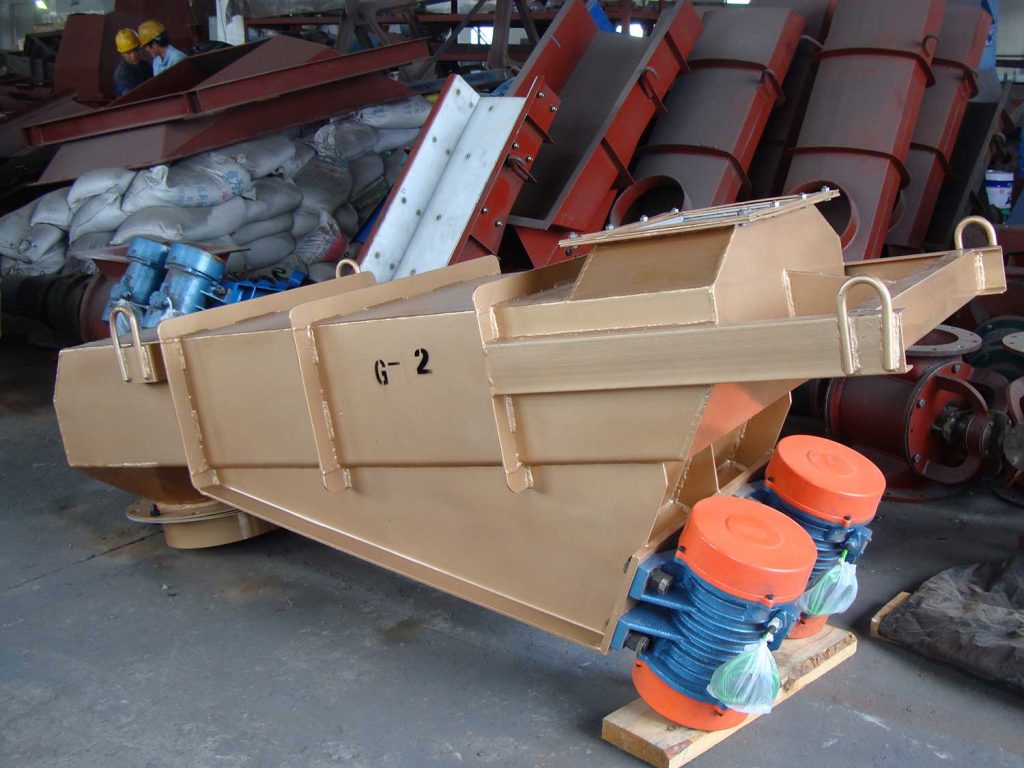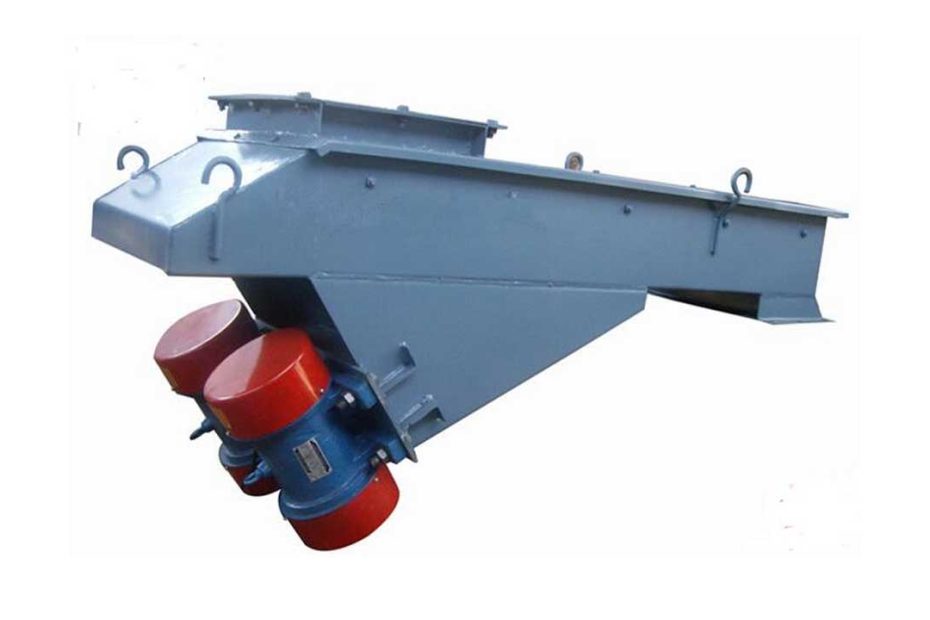Vibrating feeders are essential components in various industrial processes, used for the controlled and precise feeding of materials. These machines rely on robust load-bearing components to withstand the dynamic forces and vibrations they generate.
Vibrating feeders are employed in sectors such as mining, construction, agriculture, and manufacturing to transport and dispense materials consistently and efficiently. Vibrating feeders play a pivotal role in automating processes and enhancing production rates.
The load-bearing component refers to the component of the vibrating feeder that directly carries materials, and it is an important part of the feeder. Depending on the size of the load-bearing components and the nature of the materials being transported, they are generally welded with carbon steel, low alloy structural steel or stainless steel plates with a thickness of 2 to 10 mm.
Top 4 Load-Bearing Components of vibrating feeders
Several load-bearing components in vibrating feeders are critical to their structural integrity and performance. These components are designed to endure dynamic forces and vibrations generated during operation.
- Feeder Bowl : The feeder bowl is the heart of the vibrating feeder. It is typically made of durable materials like stainless steel or hardened steel and designed with a precise geometry to ensure optimal material flow. The bowl’s inner surface features ridges or spirals that facilitate the movement and orientation of materials.
- Drive Unit : The drive unit is responsible for generating the vibratory motion that moves the materials in the feeder bowl. It consists of an electric motor, an eccentric weight, and a series of springs. The motor drives the eccentric weight, creating vibrational forces that transmit to the feeder bowl through the springs.
- Support Structure : The support structure provides the foundation for the entire vibrating feeder system. It must be robust and stable to counteract the dynamic forces generated during operation. The choice of materials and the structural design of the support system are crucial for ensuring the feeder’s longevity and performance.
- Isolation Springs : Isolation springs are positioned between the feeder bowl and the support structure. They serve two critical functions: damping vibrations and isolating the feeder from external vibrations or shocks. Properly designed isolation springs prevent excessive stress on the load-bearing components and ensure smooth operation.
Top 3 points in structural design of load-bearing components in vibrating feeders
The multiple load-bearing components in a vibrating feeder are critical to its structural integrity and performance. These components are designed to withstand the dynamic forces and vibrations generated during operation.
Let’s delve into the structural design of the load-bearing components of the vibrating feeder and explore the engineering principles, materials and precautions that ensure its reliability and efficiency.
Type of load-bearing member
The load-bearing components of vibrating feeders are usually designed into two types: trough type and tubular type according to specific usage requirements. The tubular type is generally sealed; the trough type is mostly open and can also be made sealed.
The cross-section of the tank body can be rectangular, trapezoidal or triangular according to the needs of use. The bottom of the tank has two types: flat bottom and arc bottom; the cross-section of the pipe body usually has two types: rectangular and circular.
Because the load-bearing component (trough or pipe) of the vibrating feeder directly participates in vibration, its mass (or weight) directly affects the required excitation force and power consumption. The heavier the load-bearing member, the greater the power consumption, so it is desirable that the load-bearing member be light in weight.
However, since the tank or pipe body participates in vibration and is always in a higher frequency vibration state, in order to avoid the fatigue fracture of the components caused by the increase in amplitude when the tank resonates, the tank or pipe body is required to have a higher Stiffness. Generally, the material filling coefficient in the open tank is large, but the stiffness is small; the material filling coefficient in the sealed tank is small, but the stiffness is large. In order to reduce the mass of the section-bearing member and increase its stiffness, reinforcement plates are usually welded outside the tank body to increase the moment of inertia of the section.
Stiffness of load-bearing members
In order to make the load-bearing components durable under vibration conditions, it is not enough to only consider the strength when designing the tank or pipe body. Sufficient stiffness of the components should also be ensured.
(1) Overall stiffness
When calculating the overall stiffness of the tank or tube, the tank or tube can be regarded as an elastic support beam supported on a soft spring.
From top to bottom are the first-order, second-order, and third-order vibration curves of the beam. When the frequency of the excitation force is equal to or close to the first-order natural frequency of the beam, the vibration curve of the entire beam becomes an arch with two nodes; when the frequency of the excitation force is equal to or close to a certain higher-order natural frequency, the beam will appear many of arch segments and nodes.
Therefore, this near-resonance phenomenon is caused by the proximity of the natural frequency of the tank body to the excitation frequency. Resonance will rapidly increase the amplitude of the tank body, causing damage to the tank body parts and affecting the normal operation of the machine. Therefore, the design of the tank body is required to reduce its weight as much as possible while having sufficient stiffness of the whole machine (so that the first-order natural frequency of the tank body is much greater than the excitation frequency).
In order to make the tank body have the highest first-order natural frequency as possible, the weight of the tank body should be reduced as much as possible, so that the cross-sectional moment of inertia of the tank body or pipe body is large and the length of the tank body is short.
(2) Local stiffness of the tank body
Because the insufficient stiffness of a certain part of the tank body will also cause local resonance, in addition to the above requirements for the overall stiffness, each part of the tank body is also required to have sufficient stiffness.

Calculation of the center of mass of the tank
In order to ensure that the excitation force can accurately pass through the center of mass of the tank body, the moment arm is zero to prevent the body from swinging vibration, which involves the calculation of the position of the center of mass of the tank body.
It should be pointed out that the mass of the machine body when there is material in the tank The center of mass means that the center of mass of the loaded tank body does not coincide with the center of mass of the unloaded tank body. During design, it is required that the line of action of the exciting force must pass through the center of mass of the tank when the load is applied.
Top 3 Materials for Load-Bearing Components
Selecting the right materials is paramount in the structural design of load-bearing components in vibrating feeders. The chosen materials must possess qualities such as high strength, durability, and resistance to wear and corrosion.
- Stainless Steel : Stainless steel is a popular choice for feeder bowls and other components due to its exceptional corrosion resistance and mechanical properties. It maintains its structural integrity even in harsh operating environments.
- Hardened Steel :Hardened steel, known for its high tensile strength and hardness, is often used for critical components like the feeder bowl. It can withstand abrasive materials and the repetitive impact of materials being conveyed.
- Rubber or Polyurethane : Isolation springs are typically made from rubber or polyurethane compounds. These materials provide excellent damping properties and help absorb vibrations, protecting load-bearing components and enhancing the feeder’s overall stability.
| Component | Common Materials |
|---|---|
| Feeder Bowl | Stainless Steel, Hardened Steel |
| Drive Unit | Steel, Aluminum |
| Support Structure | Steel, Concrete |
| Isolation Springs | Rubber, Polyurethane |
Conclusion
The structural design of load-bearing components in vibrating feeders is a complex engineering task that requires a deep understanding of materials, forces, and dynamics. These components are the backbone of vibrating feeder systems, ensuring the reliable and efficient handling of materials in various industrial processes.
By adhering to engineering principles, selecting the right materials, and considering critical factors, engineers can design load-bearing components that withstand the rigors of operation, contributing to increased productivity and the success of industrial applications.
